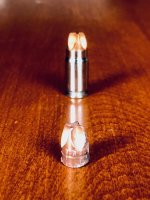Lastly, why .357 SIG with arthritis?
Some might wonder why I maintain a .357 SIG option while dealing with arthritis issues, but like colt_saa mentioned about still liking his magnums, I do see the benefit of having something around that is more powerful than 9mm.
As a normal self defense round, a 65 grain .357 SIG Underwood Xtreme Defender round, for example, is still lighter than most 9mm rounds. These extremely light projectiles travel very fast at approximately 2100 fps out of a 4" barrel to make up for their lack of mass and come in at about 636 ft. lbs. of muzzle energy which is more powerful than .40 S&W, .45 ACP and even most of the popular 10mm rounds for self defense (e.g. Hornady Critical Duty [523 ft. lbs.], Federal HST [567 ft. lbs.], Speer Gold Dots [537 ft. lbs.] and Winchester Silvertip [529 ft. lbs.]).
Shooting this round from a 34 ounce SIG P229 is unbelievably pleasant to shoot (less so from a Glock 33 I once owned). It might not be as accurate as a heavier 125 grain (or even heavier .357 SIG bullet), but it's certainly combat accurate and very powerful.
These rounds also have adequate penetration, but the lighter mass actually makes it relatively safe firing in one's home compared to testing I've seen with various calibers. I am not saying it is safer, but I do maintain these light high velocity/non expanding rounds aren't going to go through three houses either. These 65 grain XD rounds push the far end of acceptable penetration in gel testing (as Underwood rates it at 17.5" out of a 4" barrel). I did some testing with my SIG P229 (3.9" OEM barrel), however, and after going through a wall of drywall (single wall = two layers) and one layer of particle board, it bounced off a double pain glass window layer behind it (shattering but bouncing off the first layer but not even scratching the second). Here is a picture of the projectile.
So if someone comes in my house and I only have time to reach my bedside pistol, it's a very good option in my opinion.
.357 SIG is also not a bad woods gun on anything less than brown bear. I've heard good reports from law enforcement using .357 SIG on black bear, cougar, and canines as the extra energy seems to put down such animals more effectively on average than 9mm, .40 S&W, or .45 ACP (though 9mm has even brought down brown bear). This is strictly anecdotal of course.
Anyway, even though my wrists & hands bother me more as I get older, it's still nice to have fairly powerful semi-auto option like the .357 SIG. I wish Smith & Wesson still chambered M&P's in this round because it can do everything a 9mm can do (being that it is a 9mm bullet), but it also gives the option of having a fast-moving light round which has its benefits as well.
.357 SIG & .357 Magnum also seem to offer a
modest advantage in real world gunfights. .357 SIG doesn't have nearly the lethality of a shotgun or rifle round, but it is virtually as effective at incapacitating individuals as either of these options as shown here:
An Alternate Look at Handgun Stopping Power | Buckeye Firearms Association. Again, it's not a huge difference from 9mm, .40 S&W, and .45 ACP (and certainly shot placement is far more important than caliber), but it does seem that after evaluating about 1,800 bodies shot with various calibers in real gunfights, it does offer a 4-5% or greater advantage (assuming most people shoot the less powerful .357 SIG loads). That is not much, but people do things to their guns or practice certain tactics that statistically likely yield fewer real-world results. Again, I am not selling .357 SIG as clearly most of my guns are 9mm (and even .380 ACP), but I am a fan of .355" bullets in general, even with arthritis.
OKAY, IT'S TIME TO END THE QUARANTINE BECAUSE I AM POSTING WAY TOO MUCH!






